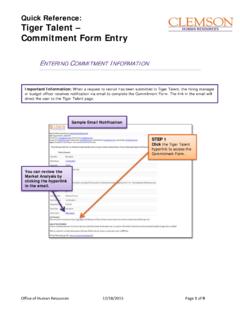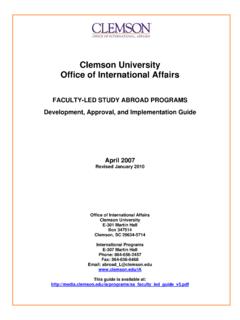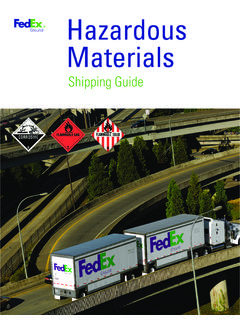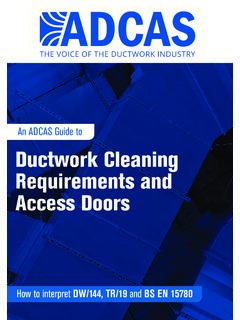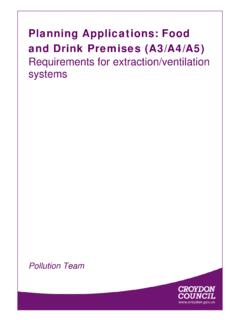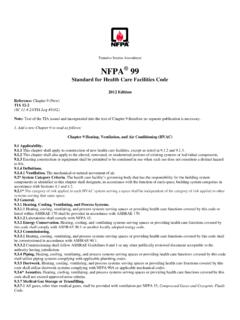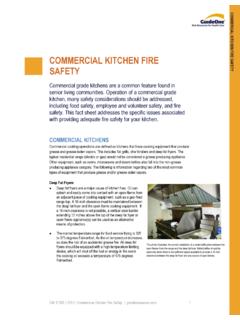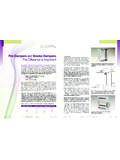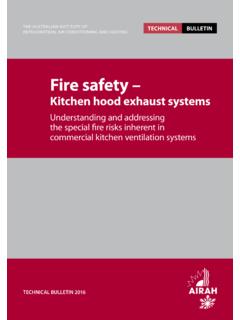Transcription of LABORATORY VENTILATION PART 1 GENERAL
1 1 LABORATORY VENTILATION part 1 GENERAL REFERENCE CODES AND STANDARDS A. Applicable Building, Mechanical, Plumbing, and Fire Codes of SC as per the Office of the State Engineer B. ANSI/AIHA , LABORATORY VENTILATION Standard C. ANSI/ASHRAE 110, Method of Testing Performance of LABORATORY Fume Hoods D. NFPA 45, Standard on Fire Protection for Laboratories Using Chemicals E. Guidelines for LABORATORY Design: Health, Safety, and Environmental Considerations Louis J. DiBerardinis, Janet S. Baum, Melvin W. First, Gari T. Gatwood, Anand K. Seth. 4th Edition F. ACGIH, Industrial VENTILATION : A Manual of Recommended Practice for Design, Latest Edition); Industrial VENTILATION : A Manual of Recommended Practice for Operation and Maintenance Publication, Latest Edition) G.
2 OSHA Technical Manual, VENTILATION Investigation, Section III, Chapter 3, H. ASHRAE LABORATORY Design Guide, 2015 I. American Chemical Society s Committee on Chemical Safety: Identifying and Evaluating Hazards in Research Laboratories, 2015 J. Fuel Gas Code K. Institute of LABORATORY Animal Resources, Guide for the Care and Use of LABORATORY Animals. L. International Fire Code 2 SCOPE A. This Standard defines Clemson s expectations for the design of LABORATORY spaces, including space layout and the design of VENTILATION systems. Such designs shall strive to balance the sustainability goals of the University while maintaining the safety and health of LABORATORY occupants and the GENERAL public.
3 It is suggested that Designers review additional LABORATORY VENTILATION information located at the Research Safety web site for further guidance. B. This Standard applies to construction of new facilities and renovations to existing facilities in which chemical work is to be done at LABORATORY -scale. Facilities in which chemical work is conducted beyond lab-scale, or for which other hazards, such as high chemical hazard, radiological or biological hazards are the design drivers may require specialty design criteria. Designers shall consult with Facilities Services and Research Safety before proceeding to determine a basis for design in order to address the special considerations for these types of spaces.
4 DEFINITIONS A. For the purposes of this Standard, LABORATORY refers to a space or facility where relatively small quantities of hazardous chemicals ( amounts that can be safely handled by one person) are used on a non-production basis. B. GENERAL exhaust VENTILATION , also called dilution VENTILATION , differs from local exhaust VENTILATION in that in lieu of capturing emissions at their source and removing them from the air, GENERAL exhaust VENTILATION allows the contaminant to be emitted into the workplace air where it is diluted at an acceptable level ( , to the Permissible Exposure Level or below).. C. Local exhaust VENTILATION systems are composed of five parts: fans, hoods, ducts, air cleaners, and stacks.
5 Local exhaust VENTILATION is designed to capture an emitted contaminant at or near its source, before the contaminant has a chance to disperse into the workplace air. D. Computational Fluid Dynamics is the use of numerical methods to calculate and visualize air flow patterns or particulate migration. E. A Vacant LABORATORY is one that is unassigned to an occupant and therefore can have the GENERAL VENTILATION and fume hoods 3 turned off or turned down to levels needed only for GENERAL temperature control. F. Occupied mode is that which the building controls system sensors recognize that a person is physically within the room.
6 G. Unoccupied mode is that which the building controls system sensors recognize that there is no one present in the room. H. Fume hood Hibernation describes when the lab is assigned to an occupant, but the operation of the fume hood is not required, and the fume hood exhaust can be temporarily shut down. I. Air Changes per Hour (ACH): A common means for expressing a volumetric airflow through a room. Each ACH for a room is intended to represent an amount of air equal to the gross volume of air passing through the room each hour. An ACH rate for a room can be converted to volumetric airflow by multiplying the ACH number times the gross volume in the room.
7 The air change rate depends on the exhaust flow for a negatively pressurized room and on supply flow for a positively pressurized room. The term does not reflect actual mixing factors and therefore does not indicate the effective air exchange rate in the room. J. Constant Air Volume (CAV) VENTILATION system: A VENTILATION system designed to maintain a constant quantity of airflow within its ductwork. The airflow quantity is typically based upon heating or cooling load, make-up air requirements, or minimum air change requirements. Although relatively simple, a constant volume system typically requires the maximum ongoing energy usage.
8 K. Discharge Velocity: The speed of the exhaust air normally expressed in feet per minute (meters/second) of the point of discharge from a LABORATORY exhaust system. Since LABORATORY exhaust fans may be configured to discharge into a vertical exhaust stack or may utilize fans specifically designed to discharge directly upward, the discharge velocity normally refers to the air velocity as it leaves the last element of the exhaust system. Since the top of an exhaust stack may be conical (or other type of configuration), the velocity of the exhaust air at the point of discharge may differ from the velocity of the air within the vertical stack.
9 The term stack velocity is sometimes used when referring to the speed of the exhaust airstream as it is discharged into the outside air. L. Face Velocity: The air velocity of the plane of and perpendicular to the opening of a LABORATORY chemical hood. 4 M. HEPA: High Efficiency Particulate Air (filter) for air filters of or higher collection efficiency for micrometers diameter droplets of an approved test aerosol operating at a rated airflow. N. Variable Air Volume (VAV) VENTILATION System: A type of HVAC system specifically designed to vary the amount of conditioned air supplied and exhausted from the spaces served.
10 The amount of air supplied and intended to meet (but not exceed) the actual need of a space at any point in time. SUMMARY COMMENTS: A. GENERAL room VENTILATION shall be provided to prevent the buildup of fugitive emissions in the LABORATORY . A GENERAL room VENTILATION system shall be designed to maximize the r e m o v a l of contaminants from the room while minimizing overall energy use. Demonstrating VENTILATION effectiveness through design to optimize LABORATORY room air mixing and dilution is more important than delivering a bulk quantity of VENTILATION (air change per hour ACH).




